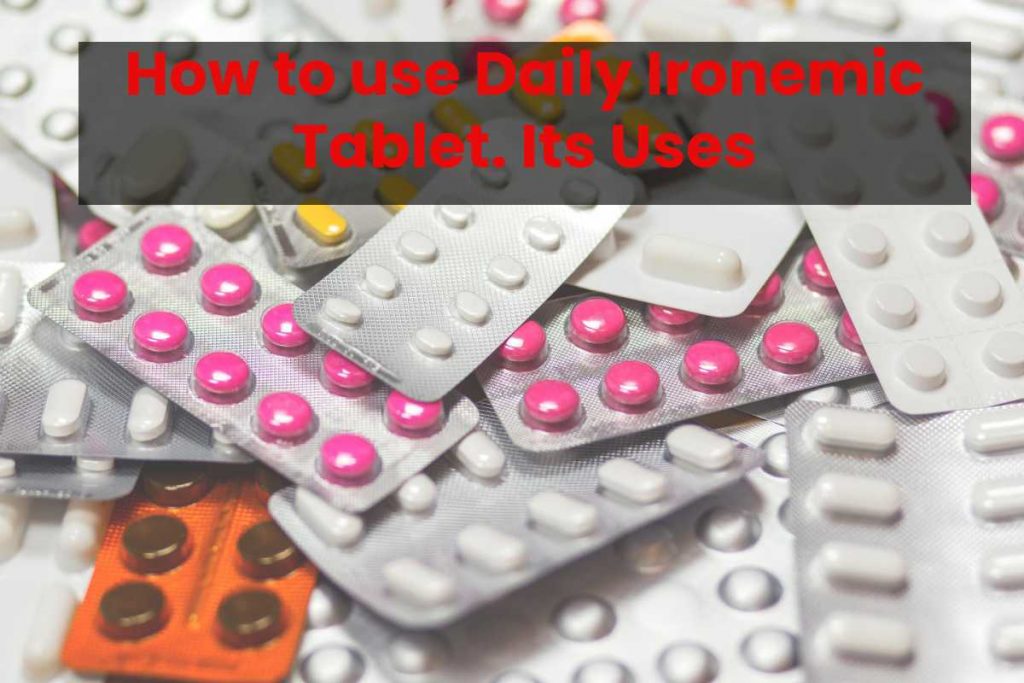Ironemic – Follow all directions on the product package, or take as directed by your doctor. Do not take more than the recommended dosage. If you have any questions, ask your doctor or pharmacist.
Ironemic is best absorbed on an empty stomach (usually if taken 1 hour before or 2 hours after meals). If a stomach upset occurs, you may take this medication with food. Avoid taking antacids, dairy products, tea, or coffee within 2 hours before or after this medication because they will decrease its effectiveness. See the instructions below for the liquid drops for infants/children.
Take tablets or capsules with a full glass of water (8 ounces or 240 milliliters) unless otherwise directed by your doctor. Do not lie down for at least 10 minutes after taking your tablet or capsule dose.
Swallow extended-release capsules whole. Do not crush or chew extended-release capsules or tablets. Doing so can release all the drugs at once, increasing the risk of side effects. Also, do not split extended-release tablets unless they have a score line and your doctor or pharmacist tells you to do so. Swallow the whole or split tablet without crushing or chewing.
Table of Contents
Who Should Take Ironemic Supplements?
Iron is a nutrient that plays many vital roles in your body, including keeping you healthy and full of energy.
Low iron levels are typical and can cause unpleasant symptoms like tiredness, poor concentration, and frequent bouts of illness. However, iron deficiency is not always easy to spot, especially in its early stages.
Iron supplements are a great way to reverse a deficiency, especially if diet changes alone are unsuccessful.
This article discusses iron supplements, who may benefit from them, as well as the best ways to get your iron levels tested.
Getting Tested for Low Ironemic
Getting your blood tested is one of the best ways to diagnose low iron levels or IDA. As the conditions can be difficult based on symptoms alone.
One complementary approach is to consider how your dietary and supplemental iron intakes compare with the recommended ones.
It may be helpful to understand the importance of requesting specific blood tests over others to understand the three main stages of iron deficiency.
Low Ironemic levels Typically Progress to IDA Through these Stages:
Mild iron deficiency. This condition consists of low iron stores with ferritin levels between 10–30 mcg/L, a normal red blood cell (RBC) count with hemoglobin above 12 g/dL. And hematocrit above 36% for women and 41% for men.
Mild functional iron deficiency. This condition consists of depleted iron stores with ferritin levels lower than ten mcg/L but an average RBC count with hemoglobin above 12 g/dL and hematocrit above 36% for women and 41% for men.
Iron deficiency anemia (IDA). This condition consists of depleted iron stores with ferritin levels lower than ten mcg/L, an RBC count falling below the normal range with hemoglobin below 12 g/dL. And hematocrit below 36% for women and 41% for men.
Best Tests to Diagnose your Iron Status
Hemoglobin and hematocrit tests are commonly use to screen for iron deficiency. However, they’re not consider sensitive or specific and tend only to identify IDA — not the early stages of iron depletion.
Identifying the earlier stages of depletion is beneficial, as doing so allows you to address the problem immediately —through diet modifications or supplements — rather than letting it progress to IDA before taking action.
Serum ferritin is consider the most cost-effective and efficient test for diagnosing an iron deficiency, especially in its early stages.
However, few medical professionals routinely test for ferritin levels. So you may have to request this test specifically, in addition to hemoglobin and hematocrit tests, when visiting your doctor’s office.
How Often Should you get Tested?
Those with no history of low iron levels may get their levels test once per year to detect a potential iron deficiency in its early stages.
If taking iron supplements, improvements in hemoglobin may be noticeable within four weeks. However, it generally takes at least three months to utterly replete hemoglobin levels and sometimes even longer to rampant ferritin levels.
Therefore, people taking supplements to treat an iron deficiency should wait at least three months after beginning treatment. If not slightly longer. Before getting their hemoglobin and ferritin levels retested.
That said, a small proportion of people either do not respond to oral iron supplements or experience side effects. As such, they may need other treatments.
Therefore, if you have IDA and fail to notice any improvement in symptoms within the first 4–8 weeks of taking a supplement. Consider getting your hemoglobin levels retest to check whether you’re responding to the treatment.
Conclusion:
Ironemic supplements can help reverse an iron deficiency when dietary changes alone are unsuccessful. Certain people, including pregnant women. Infants, young children, heavy exercisers, and those with certain medical conditions, are more prone to low iron levels and should get their iron levels test regularly.
